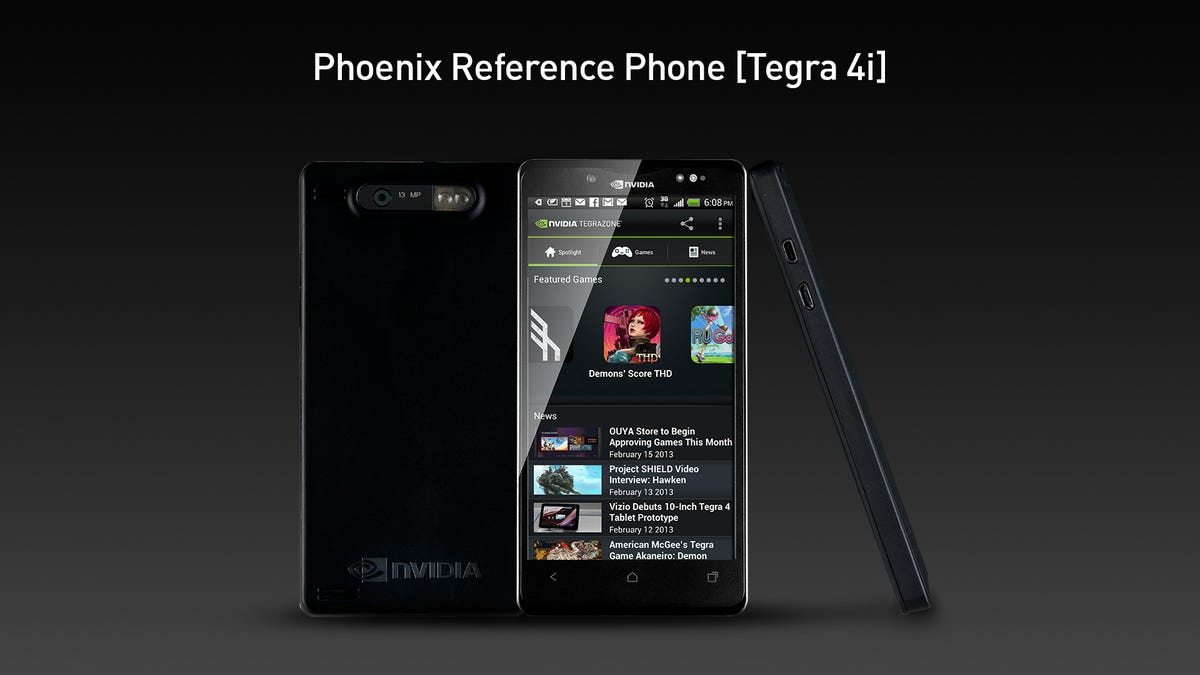Nvidia’s big chance to expand into smartphones has arrived and it’s called Tegra 4i.
The company today unveiled its new mobile chip that integrates its app processor and 4G LTE on the same piece of silicon. The processor, previously codenamed “Project Grey,” includes 60 Nvidia GPU cores, a 2.3 GHz quad-core CPU based on ARM Holdings’ R4 Cortex-A9 architecture, a fifth low-power CPU core, and a version of Nvidia’s i500 LTE modem.
Related stories:
- Questions remain about Nvidia’s traction in mobile
- Nvidia’s CEO talks Shield with CNET
- Tegra 4, gaming dominate Nvidia’s 2013 plans
- How Microsoft became a control freak with tablet makers
- Nvidia still has a lot to prove in mobile market
- Qualcomm debuts chips with 75 percent better performance
Nvidia expects Tegra 4i to appeal to smartphone makers and help it better address that key market. While the Santa Clara, Calif., company has supplied processors for many different tablets, it has struggled to expand into the handset market, largely because it didn’t offer an integrated chip.
“This is a huge step forward for Nvidia,” Phil Carmack, senior vice president of the company’s mobile business, told CNET. “It’s the first time we’ve had an integrated solution, and it radically changes the market availability for us.”
Traditionally known for making graphics processing units found in computers and game consoles, Nvidia has been counting on its Tegra mobile chips to help offset weakness in its core PC market. So far, it hasn’t been enough. Its presence in smartphones has been minimal, and the bulk of Tegra sales are for a couple of tablets, the Google Nexus 7 and the Microsoft Surface. In addition, Nvidia now is facing more competition in the tablet market.
The Tegra 4i announcement comes only a few weeks after Nvidia unveiled its updated standalone mobile processor, Tegra 4. Tegra 4i isn’t as powerful as its sibling — Tegra 4 has 72 GPU cores — but was designed specifically to be power efficient and take up less space in a device.
Integrated chips typically are cheaper than buying separate processors for the functions, and offering such a product allows chipmakers to address low-end devices as well as those at the top end of the market. So far, Qualcomm has been the dominant supplier for such chips.
While Tegra 4i is a big step forward for Nvidia, it remains to be seen how well it ultimately does in the market. Qualcomm last month unveiled its two newest processor lines, the 600 and 800 series. Both have substantially better performance than their prior generations and integrate faster LTE and WiFi capabilities.
Qualcomm Chief Marketing Officer Anand Chandrasekher told CNET in an interview that the company remains confident in its position and that it expected competition in the LTE/integrated market sooner.


Nvidia
The LTE in Nvidia’s processor is a slower generation than the LTE in Qualcomm’s newest processors, and that’s something that could limit the company’s opportunities in the U.S., some analysts say.
However, the technology Nvidia uses for its wireless processors, gained through its $367 million acquisition of Icera in 2011, allows them to be updated using software instead of only through hardware. This technology, called a software-defined radio, means the same chip can work on 3G and 4G cellular networks and be upgraded to include new features.
“There are always tradeoffs,” Tirias Research principal analyst Jim McGregor said. “But a software-defined modem will give a lot of flexibility in terms of supporting new technologies and bands. They can upgrade the bands or specifications … just through software upgrades, not necessarily through having to develop a new chip.”
Handset makers are currently sampling Tegra 4i, and Nvidia expects the chip to ship in phones around the end of the year, including in the U.S. The company already has design wins for the processor, Carmack said, but he declined to give more details.
Along with Tegra 4i, Nvidia also introduced a smartphone reference design, dubbed Phoenix, to show the chip’s capabilities to handset vendors. Smartphone makers can use the reference design to build their own smartphones much more quickly.



